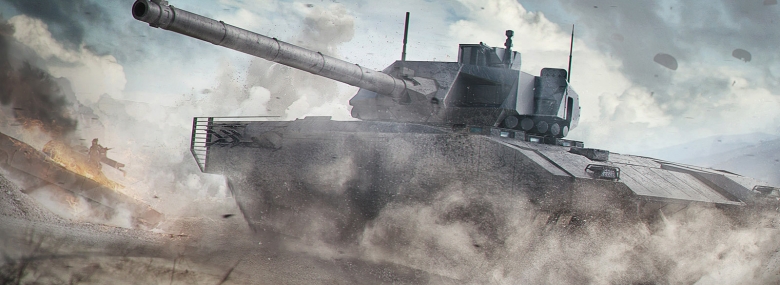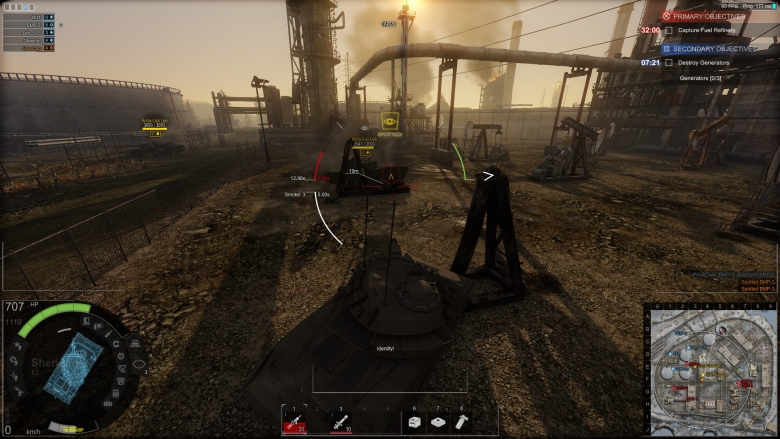
In order to damage enemy vehicles in Armored Warfare, players have to first penetrate their armor with their shots. The probability of such penetration depends on several elements:
- Target armor thickness (heavier vehicles do have a much thicker hide than the lighter ones)
- Shell type and performance (shells do have a penetration value – the amount of armor they can pierce through)
- Distance to target (kinetic energy shells lose their penetration value over distance)
- Impact angle (shots impacting at very steep angles can ricochet off the target)
To allow players to quickly determine the likelihood of penetrating, a feature called the Penetration Indicator was implemented into Armored Warfare.

Whenever players move the aim reticle over their intended target, the reticle changes colors:
- Green: penetration is likely (as is the case on the picture above)
- Yellow: penetration is possible but not guaranteed
- Red: shells will not penetrate
Shell Types
The main types of shells in the game are the following:
Armor-piercing shells should be the most reliable of all types and able to deal predictable, if not the highest, amount of damage while keeping high penetration values, high muzzle velocity and high accuracy. They should be the best shells against heavily armored targets and for sniping.
HEAT shells and missiles should be the best shells against light vehicles with thin armor as well as against thinly-armored parts of heavy vehicles (such as Main Battle Tank rear), especially at close distances where accuracy is not that important, dealing massive damage to such targets, causing more module/crew damage and having a higher chance to set enemies on fire. However, their downside is their low muzzle velocity, lower accuracy and the fact their effectiveness is reduced by composite armor.
High-Explosive shells and missiles are mostly useful in the following main cases:
- When it’s impossible to penetrate the enemy armor and the player wants to do at least some damage, for example to finish off an enemy with very few hitpoints left but with thick armor
- For destroying tracks and immobilizing the enemy
- For destroying enemy vehicle modules
- For reliably preventing the enemy from capturing a base (even small damage rests the capture counter)
- For firing against targets that have almost no armor at all (typically four-wheeled AFVs)
HESH/HEP/PISH/Thermobaric shells and missiles are extremely effective against sloped armor and also have their own set of weakspots – in other words, due to their distinctive mechanics, the weak (“green”) armor zones of these shells are different than those of kinetic/HEAT shells. These shells and missiles also deal maximum damage to modules. Their downside is that they are rather rare and only appear on several vehicles, providing unique gameplay.
Please note that not all vehicles have all types of shells.

Each type of shell is suitable for different situations, although the general rule is that AP shells are universal. HEAT shells are to be used against targets without special armor and light targets and HE shells are suitable against targets with very thin armor (or very thick armor that cannot be penetrated otherwise in order to deal at least some minimal damage). Upon impact, all shells perform a penetration check (comparison of shell penetration value against armor). Successful check means that the shell does damage, unsuccessful check means that the shell does no damage at all (AP and SC shells) or only a small amount of damage (in the case of HE and HESH shells).
Armor Types
Vehicle armor can either mitigate or completely negate shell effects. There are several types of armor, each effective against different types of shells. The two basic armor types are:
- Homogenous (no particular strengths or weaknesses)
- Composite (very strong against SC shells, only found on advanced vehicles)
Each vehicle can be also fitted with additional types of armor:
- Spaced armor (essentially an additional armor plate, helpful against SC and HE shells)
- Explosive reactive armor (very helpful against SC shells but mostly useless against AP shells)
- Caged armor (helpful against SC and HE shells, useless against AP shells)
Hits and Critical Hits
No vehicle is empty inside – there are:
- Internal modules (such as engine, fuel tanks, ammunition)
- Crew members (commander, gunner, loader, and driver)
A successful penetration can either result in a regular hit (hitpoints of the vehicle are reduced by the shell’s damage value) or a critical hit – the shell damages or destroys a module or wounds a crew member inside. Damaged or destroyed modules influence vehicle behavior: vehicles with a destroyed engine cannot move, a destroyed gun means the player cannot fire, for example.
These are repaired automatically to damaged status (where they work but with reduced efficiency – the vehicle gets slower, the gun gets less accurate etc.).
To remove the damaged status, players have to use repair kit consumables. Wounded crew members, however, do not automatically restore and the vehicle suffers a massive penalty to the area the crew member influences: vehicles with wounded crew members load shells much slower; vehicles with wounded drivers move and turn slower as well. To remove the wounded status, players have to use first aid kit consumables.
In certain rare cases, critical hits can have additional effects as well. Hitting a fuel tanks can set the vehicle on fire, which will consume the hitpoints until extinguished (either by extinguisher consumable or by itself in time, some advanced vehicles can unlock automatic fire extinguisher systems as well).
Hitting an ammunition rack can also cause a fire.






